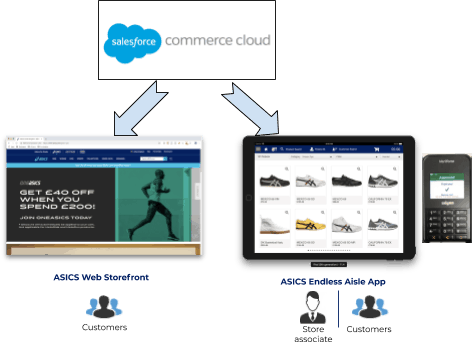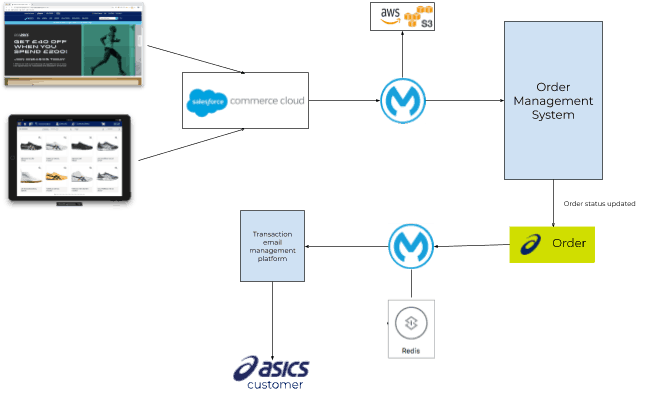Over the last few years, eCommerce has boomed and quickly become an important part of our day-to-day lives. The line between online and in-store shopping experiences is diminishing.
At ASICS, it is our goal to provide a seamless and consistent experience to customers around the world, whether they are shopping online from a desktop or mobile device, by telephone, or in a brick-and-mortar store. Having our business based in various regions – stretching from Japan in the east to the U.S. in the west – one of the biggest challenges is ensuring the alignment of different vendors offering PIM (Product Information Management), OMS (Order Management System), and PPS (Payment Processing System) solutions for each region.
When we initially tackled the problem, it was complicated to import data from diverse vendors to a central system, Salesforce Commerce Cloud (SFCC), and then to export it after customers had placed their order. At the same time, it was a complex issue to have a sophisticated global view for internal stakeholders and external customers. As a result, we had to build an integration system that would take data from different sources and transform it into a single form for SFCC and vice-versa.
Using DataWeave to scale ASICS eCommerce
DataWeave is the MuleSoft expression language for accessing and transforming data that travels through a Mule app. Based on our analysis to connect multiple backend systems in a time-efficient manner, we built a solution with MuleSoft’s Anypoint Platform and Dataweave. Different region-based product information systems publish information required to market and sell ASICS products in its region. Data from each region course through Anypoint Platform to transform into a single schema, which can then be imported to our central PIM which is managed using Salsify. The DataWeave transformation not only helps us in maintaining a uniform structure of the product data but also in creating a scalable solution that can address additional regions we plan to support in the future.
When product catalogs are published from central PIM, they go through another DataWeave script to be transformed and imported in Salesforce Commerce Cloud. To offer an omnichannel experience, we needed to design the DataWeave transformation with a holistic approach that would handle multiple languages and countries, no matter how or where our customers reach out.


OMS, another core building block of our eCommerce backend system, is managed via Anypoint Platform as its middleware. Once an order is placed on the ASICS website or in-store via the Endless Aisle app, DataWeave is designed to transform data to different formats required by various endpoints. Since Anypoint Platform is a single unified platform, it was possible for us to build and deliver applications faster. Furthermore, we were able to ensure the robustness of the applications built on it.
As ASICS eCommerce has scaled from one region to many on Salesforce Commerce Cloud in a very short time by using Anypoint Platform, we were able to future-proof our architecture and scale it on-demand. Building MuleSoft applications for integrating with order management systems also provided us with an opportunity to become familiar with the data caching ability on the platform— it was used to cache transactional email data to avoid sending duplicate emails to the customers when the status of their order is updated within OMS. Using Anypoint Platform, we are able to send real-time transaction emails to the customers as well as archive order updates on simple storage service offered by Amazon Web Services (AWS) using S3 connectors.

Migrating to Salesforce Commerce Cloud with Anypoint Platform
Additionally, Anypoint Platform has been a key system in our backend migrations. ASICS eCommerce has been migrated from a legacy commerce platform to Salesforce Commerce Cloud for most of the regions across the globe. In order to provide customers with an uninterrupted experience before and after the migration, we leveraged Anypoint Platform to not only transform the customer data within a valid Salesforce schema but also use appropriate aggregate functions to provide customers access to our OneASICS loyalty program.
Above that, we were also aiming to provide customers access to their order history, independent of the platform on which they have placed the orders. We were able to achieve that by using DataWeave to transform historical orders to import them on Salesforce Service Cloud. One of the biggest advantages of using Anypoint Platform is the ability to perform the necessary transformations securely. We were able to build the applications for one region-based business and reuse data models for any of the subsequent migrations. Using out-of-the-box connectors made it possible to build data flows rapidly and deploy them on Cloudhub.

Finally, all the applications are hosted on CloudHub, with which we are able to deploy a number of applications with agility. CloudHub provides us with development and production runtime environments that enable us to boost our development and testing speed as well as lower the cost of building distributed architecture internally.
ASICS’ results
Taking advantage of the various universal functionalities provided by Anypoint Platform, we were able to increase our productivity by more than 2x. We also expanded our channels in less than two months of development time for customers to reach us, thereby providing a true omnichannel experience and increasing 5% of the overall retail sales in Europe during the first quarter of 2019. It is impressive to see the application developed at full capacity and making a positive impact on ASICS business growth.
To learn more about how ASICS is using Anypoint Platform, check out the ASICS case study.
Coming to Salesforce Connections in Chicago?
See the ASICS story come to life in person! Kreena Mehta from ASICS will be joining us at the Connect Commerce with MuleSoft session on Wednesday, June 19 from 9:15 AM to 9:55 AM in Session Room W475A.









